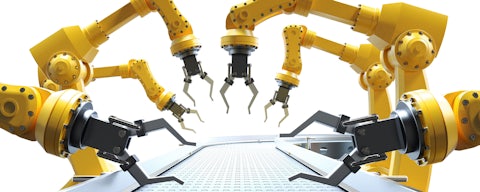- Blog
Interested in intelligent automation? Start with RPA

As more organizations automate their key processes, they are building businesses where employees are no longer spending their valuable time on repetitive and time-consuming tasks. They are doing this to streamline processes, reduce costs, and remain competitive.
So what's the secret to their success?
It all starts with robotic process automation (RPA). For the uninitiated, RPA replicates rule-based tasks such as data migration and validation, generating mass emails, creating and processing invoices, and more. It drives value through its speed and elimination of errors, with a relatively low investment. Think about RPA as a virtual workforce of robots that allow humans to focus on more complex tasks that require strategic thinking.
Today, the window of opportunity is widening beyond RPA. By adding AI, machine learning, natural language processing, and analytics into the mix, RPA is evolving into intelligent automation, which delivers exponential value by learning and adapting as it automates. But to make the leap to intelligent automation, you need to start with a solid RPA strategy.
Identify automation opportunities
The magic of automation does not happen overnight. And it doesn't work with every process. For automation to deliver the most value, companies need to think through end-to-end operations to spot the best opportunities. Once you have some in mind, ask yourself some questions. Why should we automate these steps? What are the expected benefits? Can we measure the ROI? Just because a process can be automated doesn't mean that it should be if you can't answer these questions.
Make time for deployment
True transformation is a lot of work. The best organizations use a "think big, start small" approach, forming an automation plan that scales over time. In planning, it's important to consider how to embed automation seamlessly into existing programs and initiatives, without disrupting other parts of the business.
Plan for command and control
An automated workforce is different from a human workforce. With humans, it's easy to see if a person doesn't show up for work or a deadline is missed. With bots, if a process is broken or a sudden change causes a bottleneck, it might not be noticed as quickly. Governance is critical for overseeing performance, especially as automation scales across an organization.
Use industry expertise
When applying automation, you need to consider the big picture. A solid understanding of the industry your business operates in will help. Without this expertise, it's practically impossible to build the right solution or achieve your automation objectives. After all, every industry has its nuances. At Genpact, when we combine our industry and process expertise with digital capabilities, we deliver significant return on investment. We even have a range of pre-configured bots for different industries, as well as customizable connectors, to get businesses started with RPA more quickly.
Once this foundation is laid, businesses can move beyond the basics and automate processes that previously only human cognition could address. For example, natural language processing can pull unstructured data from disparate documents and combine it with other data for new insights. Or why not use dynamic workflows to route tasks around the digital and human workforce based on real-time information? And through predictive analytics, AI can shine a light on what's to come, providing insights with which people can make informed decisions.
Visit our automation solutions page
Intelligent automation
Into the future, we will see more technologies converge to form new cognitive capabilities, leading to better and more adaptive processes. Ultimately, once you have a solid RPA strategy, you can explore the next era of automation, leveraging AI to achieve better business outcomes.

